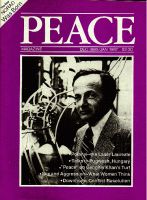
Peace Magazine Dec 1986-Jan 1987, page 6. Some rights reserved.
Search for other articles by Andrew Van Velzen here
In 1982 the United States Army released a new aggressive war-fighting doctrine known as AirLand Battle. The doctrine outlined in Field Manual 100-5 emphasizes offence, a high degree of mobility, and "deep strikes" far into enemy territory behind the front lines of battle.
The manual says that the U.S. Army faces a number of challenges in the 1980s and must be equipped to fight "light, well-equipped forces such as Soviet sup-ported insurgents or sophisticated terrorist groups. It must be prepared to fight highly mechanized forces typical of the Warsaw Pact or Soviet surrogates in southwest or northeast Asia (the Middle East or Korea). In the areas of greatest strategic concern, it must expect battles of greater scope and intensity than ever fought before. It must anticipate battles fought with nuclear and chemical weapons."
The key to AirLand Battle, the manual says, is to seize the initiative and disrupt the opponents' fighting capability with deep attack, firepower, and manoeuvre. The doctrine, components of which NATO adopted in 1984, will use chemical and nuclear weapons to strike deep into enemy territory to destroy infrastructure and logistical support. "By extending the battlefield and integrating conventional, nuclear, chemical, and electronic means, forces can exploit enemy vulnerabilities anywhere."
Although it talks about three major areas--Europe, Korea, and the Middle East-4t is the Middle East where the doctrine will most likely be employed. Unhindered access to Persian Gulf oil is a mainstay of American military and foreign policy. "AirLand Battle doctrine makes war--even nuclear war--in the Middle East more likely," says military analyst Martha Wenger. The doctrine "emphasizes seizing the initiative and presupposes a clear bias toward offensive strikes; and it promotes small nuclear-equipped forces as a rapidly deployable substitute for larger, conventionally armed forces." The U.S. Army has been applying AirLand Battle to Middle East conditions at Fort Irwin, California, where troops fight mock Soviet counterparts on half-a-million acres of desert.
To execute AirLand Battle, the Army is equipping its troops with highly sophisticated conventional weaponry or "emerging technologies," as they are known. Some of these are communications immune to jamming, improved C31 (Command, Control, Communication, and Intelligence), and deadly conventional weapons such as "smart munitions" that guide themselves to their targets, aided by super-computers. Despite Army assertions that the use of high-tech conventional weapons will make nuclear war less likely, nuclear weapons are an integral part of AirLand Battle. Although the U.S. has always maintained the right to use nuclear weapons first, previous doctrine stated that nuclear weapons were to be used only if conventional means proved inadequate. AirLand Battle has altered that concept. The field manual outlines preferred targets for nuclear weapons: enemy nuclear delivery systems, key command and control elements, and support forces in the rear.
Deep strike" is an essential component in disrupting an opponent's forces in depth so as to prevent the opponent from massing. The manual cites Israeli actions as good examples of the effective use of deep strikes. Nuclear weapons are especially useful in the deep strike situation, the manual says.
"Nuclear weapons are particularly effective in engaging follow-on formations in depth because of their inherent power and because of reduced concerns about troop safety and collateral damage." The manual simply means by this that the farther away the nukes are used from U.S. troops, the less likely they are to suffer exposure.
Some of the battlefield "nukes" for AirLand Battle are far more powerful than those dropped on Hiroshima or Nagasaki--13 and 23 kilotons, respectively. The Lance nuclear missile has yields ranging from one to 100 kilotons, and Pershing 1A missiles range from 60 to 400 kilotons.
AirLand Battle, a hotly debated issue in the European peace movement, has not been talked about at all in North America, despite its dangerous implications. AirLand Battle, with its integration of "battlefield" nuclear weapons into the attack plan of high-tech conventional warfare, in the Middle East or elsewhere, has heightened the potential for nuclear war. Its testing in Labrador should be of major concern to Canadian peace activists.

Peace Magazine Dec 1986-Jan 1987, page 6. Some rights reserved.
Search for other articles by Andrew Van Velzen here